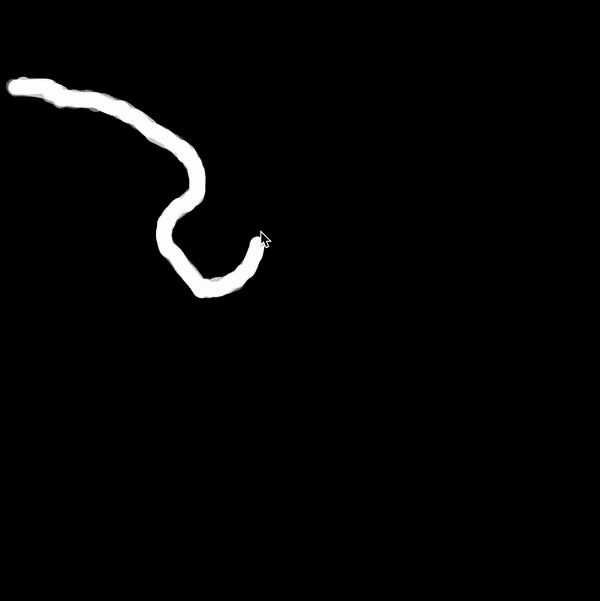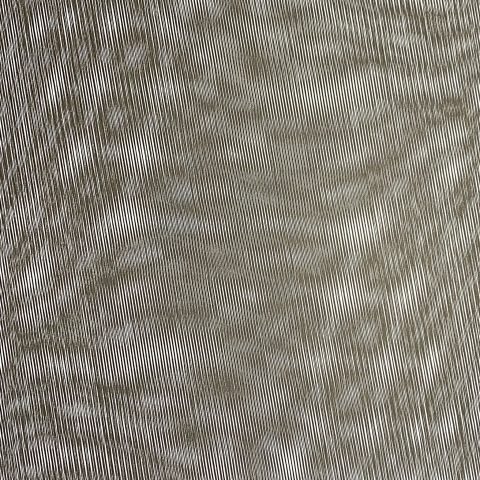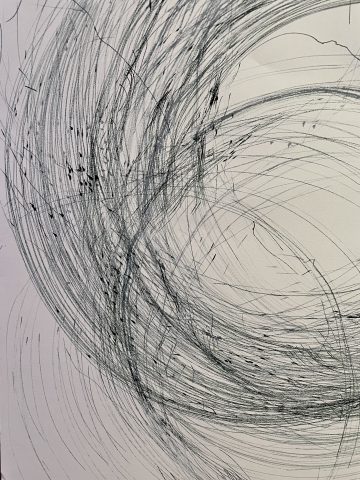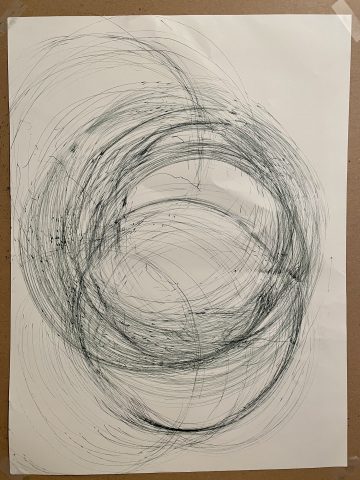
Drawing with Machines • 60-428
CMU School of Art / IDeATe, Fall 2021 • Prof. Golan Levin
I was interested in creating a line that expresses a human-like scribble that has the stroke appearance of a 0.5mm ball point pen. I messed around with sine and cosine functions that ended up creating anelliptical, vortex-like, scribble that has a direction that varies with noise, where a new drawing is constantly generated (hitting the spacebar starts and stops the generating of new drawings)

//applies the noise function in creating randomness
// Uses https://github.com/zenozeng/p5.js-svg to export SVG.
var bExportSvg = false;
var runDrawing = true;
function setup() {
createCanvas(600, 600, SVG);
}
function draw() {
if (runDrawing == true) {
background(230);
if (bExportSvg) clear();
strokeWeight(0.2);
noFill();
var cx = width / 2;
var cy = height / 2;
var px = cx;
var py = cy;
var direction = random(PI / 2, PI);
beginShape();
for (var i = 0; i < 2000; i++) {
var increment = 3 + noise(i / 1000);
var displacementX = px - cx;
var displacementY = py - cy;
var offset = max(3, sqrt(displacementX ** 2 + displacementY ** 2) / 20);
increment *= 0.7 * offset;
direction += radians(50 * (noise(i) - 10));
px += 5 * noise(i) * increment * cos(200 * direction);
py += 5 * noise(i) * increment * sin(200 * direction);
var pointX = cx + displacementX * offset ** -0.8;
var pointY = cy + displacementY * offset ** -0.8;
vertex(pointX, pointY);
}
endShape();
var seed = millis()**0.5;
randomSeed(seed);
noiseSeed(seed); //random noise value generated for each drawing coordinated with the seconds function, inspired by Golan Levin's Linewalk
loop();
}
if (bExportSvg) {
saveSVG("stickz_line_on_a_walk.svg");
bExportSvg = false;
}
}
function keyPressed() {
if (key == "s") {
bExportSvg = true;
loop();
}
if (keyCode === 32) { //if SPACEBAR is pressed, pause drawing
if (runDrawing == false) runDrawing = true;
else runDrawing = false;
}
}
link to code
I thought the way Lostritto defined drawing with anti-definitions was a unique and accurate way of describing the definition of drawing. For one thing, I liked how he made it clear that digital drawings should not be considered drawings, even if they are forms derived from digital paper and pen. The idea of perfecting “undoing” a drawn mark is not possible with physical drawing, which separates the physical practice from digital drawing. I also think the way he states how “computing technology can augment, but not replace, drawing technology” is another great point that distinguishes the characteristics of drawing, where the act of drawing will forever be a human task, even if machines can assist and do the work for us. I think the idea that drawing is done by humans will stick with me for the rest of the course, where I hope my drawings will keep the human characteristic and read as something created by myself, rather than one created by a machine.
In reading Tyler Hobb’s article 9 Tips to Execute Generative Art With a Plotter, I learned that he applies a “sorting algorithm” to increase the efficiency of plotting time, which I think is really interesting and another factor to consider when creating generative art with Axi-Draws.
In the reading “Pen Plotter Art & Algorithms”, by Matt Deslauriers, I found the convex-hull module to be a helpful tool used to create polygons, where it draws them based on a data set of points. I will definitely try this out and experiment with the convex-hull module in creating recursive drawings.
#PlotterTwitter showcased really impressive AxiDraw artwork overall, where each artist shared unique styles and approaches towards creating intricate linework. For me, I noticed that after looking through many of the AxiDraw drawings, the line harsh and defined line quality becomes a bit repetitive, where the drawings become stiff, and have that static quality. I became more interested in works that moved beyond spinograph variations and moved past the machine-like quality. Jakub Antolak's "Figura 63" was one which I thought stood out from the other AxiDraws. The texture, due to the variation in line-width and density between strokes, feels organic, almost like a close-up view of muscle fibers or a microscopic view of cells. I think a lot of this is caused by the intricate cross hatching with a super-fine pen, that when overlapped, creates the illusion of "thicker" and "thinner" strokes. I think it's also interesting how the piece is symmetrical, where the image is mirrored across the diagonal line that runs from the upper right corner to the lower left corner. I wasn't able to notice that the image was symmetrical at all at first glance, where the organic nature and the crisp linework allows your eyes to become lost in its form.

Figura 63 #plottertwitter #axidraw #generative #generativeart #creativecoding #javascript #algorithmicart pic.twitter.com/TSNuGigjmQ — Jakub Antolak (@jakub_antolak) August 30, 2021
https://twitter.com/jakub_antolak/status/1432387721167876099/photo/3
A bouncy, almost perfect double-circle drawing tool.
[videopack id=”240″]https://courses.ideate.cmu.edu/60-428/f2021/wp-content/uploads/2021/09/stickz-drawingMachine.mov[/videopack]
Close-up

Entire Drawing
